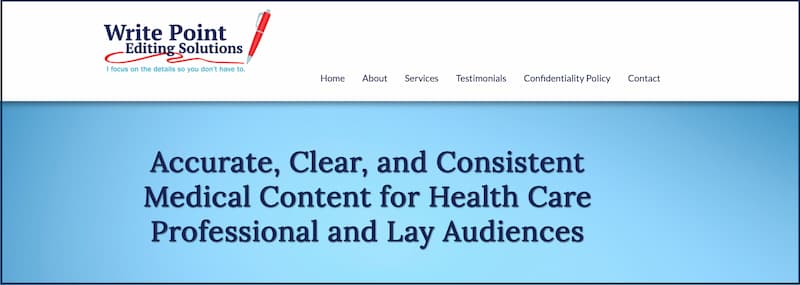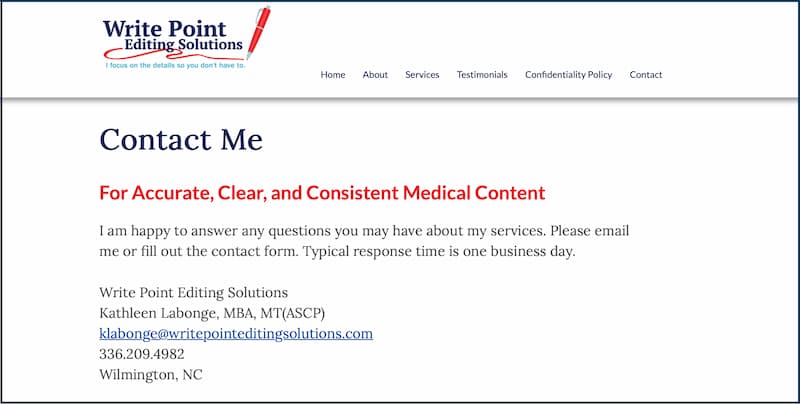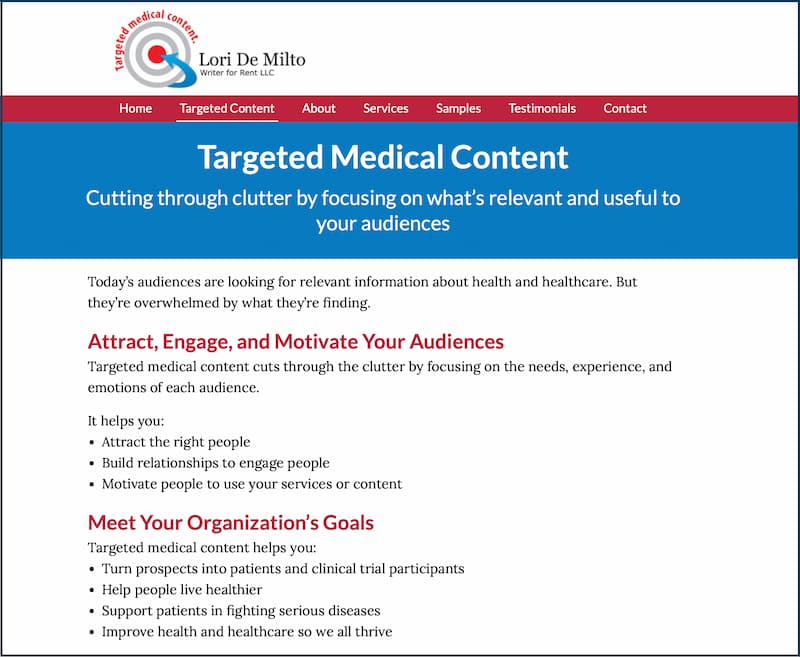How to Make your Web Content Awesome, with Free Checklist
 Awesome web content sets you apart from other freelancers and persuades high-paying clients to choose you. It helps you attract bigger, better freelance jobs and clients, and build a stable, successful freelance business.
Awesome web content sets you apart from other freelancers and persuades high-paying clients to choose you. It helps you attract bigger, better freelance jobs and clients, and build a stable, successful freelance business.
Attract high-paying clients and get more referrals from colleagues with awesome web content. Every freelancer can develop awesome web content. It just takes some time and effort.

If you already have a client-focused LinkedIn profile, you should have most of your key messages and much of the information you need for your web content.
This Mighty Marketer blog post shows you how to develop awesome web content. It features examples from the websites of three freelancers: Kathleen Labonge, Genevieve Walker, and me.
Client-Focused Web Content
Clients care about one thing: “What’s In It For Me?” Your web content needs to quickly answer that question by telling them:
- What you do (your services)
- Who you do it for (your target clients)
- How what you do benefits clients.
Colleagues who have work to refer want to quickly see that you’re the right person for the project.
If you’re not a writer, hire a freelance writer to help with your content.
Free: Awesome Freelance Website Checklist
Click here for your free checklist for your website content, writing, and design.
Meet Client Needs
Client-focused marketing focuses on the needs of your clients and how you can meet their needs. Having a strong specialty helps you understand what your clients need—and makes all of your marketing easier. And it’s not hard to figure out what your clients need.
Compel Clients with Key Messages
Client-focused content is compelling content. Highlight the benefits clients get when they work with you in key messages. Use your key messages in headlines and subheads.
Being clever is great if it contributes to your key messages. But being clear is much more important. If clients don’t know what your key messages mean, they’ll move on to the next freelancer on their list.
So here are some examples of key messages in web content.
Kathleen Labonge’s logo and home page banner headline clearly and concisely tell clients what she does. Her key messages offer two benefits:
- Sparing the client from having to focus on the details
- Accurate, clear, and consistent medical copyediting.
 And freelance medical writer Genevieve Walker’s home page also clearly tell clients what she does and how she’s different than other freelancers.
And freelance medical writer Genevieve Walker’s home page also clearly tell clients what she does and how she’s different than other freelancers.
Genevieve is truly an expert in health literacy, plain language, and readability, unlike many other freelancers who say they do this type of work. So key benefits of working with Genevieve include:
- Value (clients get what they are paying for)
- Content that patients can actually use.
Web Content About You
Start the About page with one to three sentences about how the client would benefit by working with you.
Then briefly include the most relevant (to clients) information about your:
- Experience
- Education
- Awards and honors
- Other professional accomplishments.
And if you want to provide more information, link to a subpage with your resume or a longer bio.
Include a professional headshot.
Genevieve’s About page tells clients everything they need to know about her and is easy to scan.
Note her benefit-oriented subhead:
“Experience. Insight. Evidence-based content for patients and providers.”
Also note her lovely photo.

Web Content About Your Services
Services is an easy page to write. Select categories based on the type of work you do and use bulleted lists for services under each category.
So sample categories could include:
- Services (e.g., writing, editing, consulting, publication management, and training)
- Projects (e.g., articles, blogs, continuing medical education, white papers, newsletters, web content, and social media)
- Areas of expertise, topic areas, or therapeutic areas (e.g., cardiovascular disease, cancer, diabetes; banking and financial planning).
And here’s part of my Services page. The drop-down menu keeps the page uncluttered and lets clients quickly find what they’re most interested in.

Web Content About Your Portfolio, Samples, or Work
This is another easy page to write. If you have samples you can share, use categories that make it easy for clients to find what they’re most interested in. Also use categories that let you highlight the type of work you most want to do.
If your work is proprietary, instead of samples use a project list and/or brief project descriptions to show what you’ve done. Write about what you’ve done and the type of clients you work with without mentioning names of clients or specific projects.
If you’re a new freelancer, put a little information about your work on your Services page instead of having a separate page for this. Add a few paragraphs with some project descriptions and/or use samples like:
- LinkedIn articles
- Volunteer work for professional associations
- School projects
- Spec samples (a speculative sample that’s like a project you want to work on).
Web Content About Clients
The Clients content is also easy to develop. Choose categories that let you highlight your most important services and interests, such as industries or types of work. Or just list your clients. Using a partial list of clients, labeled “Sample Clients” or “Select Clients,” is a good idea.
If you’re a new freelancer, you won’t have a client page yet. That’s fine. Add it when you’re ready. If you only have a few clients, instead of a separate page, add a Sample Clients section on your Services page.
Testimonials Web Content
What others say about you is far more powerful than what you say about yourself. Testimonials from satisfied clients help you attract more clients—because new clients want to know that other clients found your services valuable.
You can combine Testimonials with Clients on one page, have two separate pages, or sprinkle testimonials throughout your website.
If you’re a new freelancer, you won’t have testimonials, or enough testimonials for a separate page, yet. If you have one to three testimonials, sprinkle them throughout your website. Add a testimonials page when you have about six testimonials.
Here’s part of my Testimonials page.

Contact Web Content
Make it easy for people to contact you with a simple Contact page. Include your name, email address, and phone number. I recommend that you also include your city and state, to help show that you’re running a real business.
Start your Contact page with a call to action (what you want the client to do). A call to action starts with a phrase or sentence that urges the prospect to take action now, like:
Contact me today.
The best calls to action include a benefit.
So here’s Kathleen’s Contact page. Her call to action is:
“Contact Me For Accurate, Clear, and Consistent Medical Content.

Don’t use a contact form. Your goal is to build relationships with prospects, and contact forms are distant and annoying. Plus, when a client decides to hire or consider you, he/she almost always wants to reach you fast. Contact forms may be necessary for corporations and other big organizations, but they’re never appropriate for, or helpful to, freelancers.
Also include contact information on every page of your website (I think this works best at the bottom of each page).
Extra Web Content for Freelance Marketing
Genevieve and I both have an “extra page” on our websites. If you have a specific type of expertise, work, or philosophy to highlight, you can do this too.
Why Plain Language?
Genevieve’s extra web page is called “Why Plain Language?” As she says on this page, “plain language is a movement and a style of writing that puts information in simple language the public can use.”
Plain language writing is a very specific type of writing. Many freelancers claim to do plain language writing but few are actually experts.
Genevieve has studied plain language, health literacy, readability principles for print and digital media, and patient education principles for years. “The ‘Why Plain Language?’ page, which I added at Lori’s suggestion, demonstrates my passion for plain language,” she says. “It shares a bit of what I know and what it’s like to work with me,” she says.
Here’s part of Genevieve’s “Why Plain Language?” page. Note the link near the top to her samples of plain language writing.

Targeted Medical Content
My extra web page focuses on targeted medical content. This is my marketing theme. Targeted medical content is more of a philosophy rather than a specific area of expertise. It’s my way of saying that I know what the audience(s) needs and write content that helps the client reach its audience(s).
So here’s part of my targeted medical content page.

Awesome Web Design to Attract Bigger, Better Freelance Jobs and Clients
Work with a professional designer to highlight your content with a design that’s visually engaging, clear, and easy to navigate.
Learn More About Professional Website Design
Why a Website Designer Can Help You Get High-Paying Clients
Learn More About Web Content for Freelancers
Websites
Free: Awesome Freelance Website Checklist
How to Win High-Paying Clients with Your Freelance Website
Why a Website Designer Can Help You Get High-Paying Clients
Win More Clients with a Remarkable Home Page
5 Deadly Website Mistakes That Most Freelancers Make
